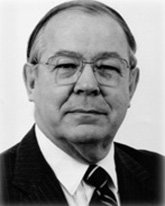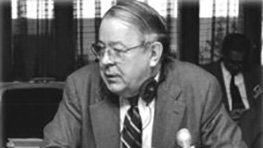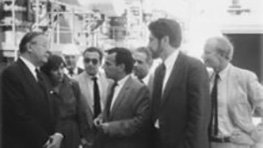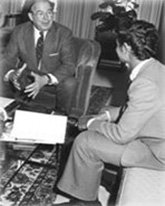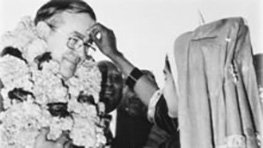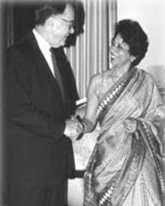6th President of the World Bank Group, July 1, 1981 - June 30, 1986
He championed increased structural and sectoral lending and expanded aid coordination (including consortia, consultative groups, and close collaboration with the IMF.) Clausen was very much in sympathy with the emphasis on markets. He was more successful in adjusting Bank policies to deal with the recession and debt crisis, and less successful in the tricky politics of Washington. He announced his intention to retire at the end of his five-year term, and he was promptly asked by Bank of America to return to resolve problems that had developed in his sojourn.
Personal History
A. W. Clausen was born in the small town of Hamilton, Illinois. After college graduation he joined the Army Air Corps in 1944. He studied law at the University of Minnesota, and passed his bar exam in 1949. He found a part-time job at BankAmerica in Los Angeles, discovered that he liked banking, and began an executive training program at the bank. He quickly became known for his hard work and attention to detail. By the age of 42 he became a senior vice president, and was then promoted to executive vice president and a member of the bank's chief policymaking committee.
In 1968 he became responsible for the bank's international lending business, an experience which would serve him well when he came to the World Bank. In 1970 he became president and CEO of BankAmerica, which he turned into one of the most profitable banks in the United States.
A.W. Clausen passed away on 21 January 2013 in Hillsborough, California. He was 89.
Economic and Political Context
In July 1981, when Tom Clausen assumed the presidency of the World Bank, the international economy was deep into one of the worst recessions of the post-World War II era. This situation particularly affected the developing countries, which found it difficult to finance their essential import needs. In addition to the recession, a major political shift had taken place – liberal thinking which focused on the need to address social inequalities by government actions had given way to a new conservatism in economic policies which emphasized the role of the private sector and unobstructed markets.
At the same time, borrowing countries throughout the world were pressuring the Bank for increased assistance, especially in quick-disbursing form. This pressure was due to the decline in net capital flows to the developing countries - commercial banks almost halved their net lending between 1981 and 1982, while major industrial countries were reducing their official development assistance because of budgetary restraints.
The debt crisis of the early 1980s threatened the solvency of the world economy and brought into question the effectiveness of development aid. Solutions developed by the Bank in response to this crisis would have long-term effects for the Bank's lending and its standing in the world political and economic picture.
Clausen seemed the right person to meet the challenges of the early 1980s. As a commercial banker he looked for solutions in market-oriented development strategies; he felt more comfortable with the private sector than with government bureaucracies; he shifted the concern from the distribution of wealth back to economic growth; and he would take his cues from the financial markets rather than the demands of the developing countries.
Development Agenda
Clausen realized that the Bank had to find new ways to continue its development work in a troubled international economy. "The World Bank in the 1980s is going to have to continue to be prudent and conservative, but given the realities of the world today, great demands will be made on its creativity and inventiveness as well…Redoubled resolve, redoubled effort, and, perhaps most fundamental of all, redoubled understanding" would be required. There would be "little tolerance for inefficiencies…priorities will have to be carefully defined, investment decisions will have to be scrutinized, and available resources will have to be used as effectively as possible."
For Clausen, the solution was to emphasize the role of free markets and private sector institutions. He saw a clear link between efficiency and ownership, and believed that preference should be given to the private sector. Developing countries should improve market signals and price incentives while substituting imports for expensive domestic production and increasing the efficiency of their export sectors.
He also recognized the growing interdependence of the world economy, seeing this as more significant than the paradigm of the North-South divide. He felt that the Bank was uniquely positioned to cope with this interdependence; as the largest international development institution, the Bank could not and should not try to do everything that needing doing in the development field. Instead, the Bank should concentrate on cooperation with other agencies to better utilize the scarce resources for development.
The oil crisis of the 1970s particularly harmed developing countries. Clausen saw an urgent need to promote new supplies of energy, and he announced an immediate 25% increase in energy lending, including substantial amounts for hydroelectric power projects.
The energy sector became the single most important area for the Bank's lending during the Clausen years. However, lending for energy projects soon became a matter of dispute between Clausen's Bank and the U.S. government, which viewed oil and gas lending to be functions of the private sector, and opposed any Bank proposal for lending in this field.
Clausen also emphasized the importance of lending to Sub-Saharan Africa. He fully endorsed a 1979 Bank study which examined the barriers to economic progress in Africa. The study recommended doubling the amount of aid to Africa to provide infrastructure, improve agriculture and develop energy. In addition, the Bank should work closely with the rest of the international development community to provide the needed assistance. Clausen approved of these ideas, especially the proposal for structurally redesigning economic policies to promote efficiency, to encourage better market incentives for production, to reduce subsidies to uncompetitive industries, and to promote exports.
In response to the debt crisis of the early 1980s, the Bank instituted programs of sectoral and structural adjustment. The loans and credits helped countries alter the structure of their economies in order to expand their export sectors, save on the use of expensive energy sources, and improve efficiency through more sensible resource allocation. By the time Clausen left, the Bank Group had committed a total of almost $12.5 billion for adjustment operations, including $2.5 billion in IDA resources.
The support of structural reforms required an expansion and intensification of the Bank's analytical work. The Bank became heavily involved in helping governments investigate their economic problems and identify the available solutions. The Bank under Clausen and Ann Krueger (the Bank's chief economist) gave emphasis to the issue of trade liberalization and effectively influenced the reform agenda, especially in Latin America.
Clausen's emphasis on the private sector and structural adjustment operations initially caused some concern among Bank staff, which worried that the Bank's commitment to fighting poverty was being abandoned. In 1982 an internal Bank study examined the continued relevance of poverty alleviation and concluded that it should remain an integral part of the Bank's strategy. Consequently, Clausen reaffirmed in the 1982 Annual Meetings that "a key and central aim of the World Bank is the alleviation of poverty." Clausen recognized the complementary role of efficient growth and poverty reduction, the productive potential of the poor, and the link between political instability and poverty.
Debt Crisis
The Bank, in response to borrower demands, also accelerated the pace of disbursements in a program created in coordination with other development banks and aid agencies. The Bank urged developing countries to complete projects as quickly as possible and to provide the basis for long-term growth.
The debt crisis also required closer collaboration between the Bank and the IMF. The two organizations had some history of friction and rivalry, but Clausen realized that close cooperation was a necessity. He developed a personal working relationship with IMF Managing Director Jacques de Larosiere. The two held regular informal discussions, helped to defuse tensions between their respective staffs, and instructed each body to keep the other informed of their findings and activities.
Despite these initiatives, Clausen and the Bank were criticized for not reacting more actively to the debt crisis. The U.S. government initially felt that the crisis was a situation to be worked out between commercial banks and their debtors, and that the World Bank should not be involved. The U.S. was also suspicious of the Bank's role in actively supporting policy reforms. The U.S. was also reluctant to provide further IDA funds or to support a capital increase for the Bank. However, in 1985, James A. Baker became the new U.S. Treasury Secretary and he took the lead in producing a plan to cope with the debt crisis, and he felt that the Bank should play a major role. Baker urged commercial banks to increase the flow of resources to the developing world, and commended the Bank's cofinancing efforts. He also supported the Bank's target of 20% of its new loans to be structural adjustment operations, which the Reagan administration now saw as a means of improving markets and private sector institutions in developing countries.
Mobilizing Resources
Clausen recognized that private investment was constrained by investors' inability to manage the political risks associated with investments in developing countries. Accordingly, Clausen revived an idea developed earlier in the Bank to form an investment insurance agency. Under the leadership of general counsel Ibrahim Shihata, plans for the Multilateral Investments Guarantee Agency (MIGA) began in 1986. (MIGA came into existence in 1988.)
In his search for new resources, Clausen proposed a supplemental fund from G-7 members to address the development needs of Africa, but this again was unsuccessful. However, a subsequent "joint program of action" was more successful. The program brought together donors and African governments in a cooperative program, which was based on analyses contained in the Bank's 1984 report Toward Sustained Development in Sub-Saharan Africa. Clausen was able to arrange more than $1.6 billion from various governments for this program.
Funding the Bank
Clausen was well familiar with the financial position of the Bank before he assumed the presidency, and he was primarily concerned with preserving the Bank's financial integrity and its sound functioning. He was concerned to find that the Bank was raising its funds in the capital markets at rapidly escalating interest rates in order to meet disbursements against lending commitments which were locked in over many years at rates substantially below then-current market rates.
To correcting this mismatch the Bank doubled the commitment fees on new loans, introduced commitment fees on IDA credits, and began charging supplementary front-end fees on new loans. In addition, traditional fixed-rate loans were replaced with a system of variable interest rates, adjustable every six months, based on the cost of the Bank's entire pool of borrowed funds.
IDA Replenishment
Secretary Baker, like his predecessor Donald Regan, wanted to limit U.S. financial commitments to IDA and to the Bank, and the struggle to raise funds from the Bank's largest shareholder became the source of Clausen's biggest frustration. The Reagan administration sharply curtailed the pledges the Carter administration made to IDA. This action angered several other donor nations, who then declared that they would reduce their own contributions to IDA in the interest of "equal burden sharing".
In the midst of this strained atmosphere, Clausen began the negotiations for the seventh replenishment of IDA. He again instituted a campaign to spur funding (even appealing to the Pope and to American cardinals and bishops long interested in poverty in developing countries), but was unsuccessful in getting the $16 billion that he sought, having to settle for pledges of $9 billion for the next three year period.
Clausen made no secret of his disappointment with this turn of events, emphasizing the negative consequences of this inadequate replenishment for Sub-Saharan African countries ravaged by drought, famine, declining per capita income, falling prices for their exports and increasing external debt. Fearing that the U.S. attitude toward the Bank signaled a permanent decline in development assistance, Clausen took an active role in presenting the Bank's case to the news media, business gatherings, and development organizations, a move which may have ultimately improved his successors' relations with the U.S. government.
